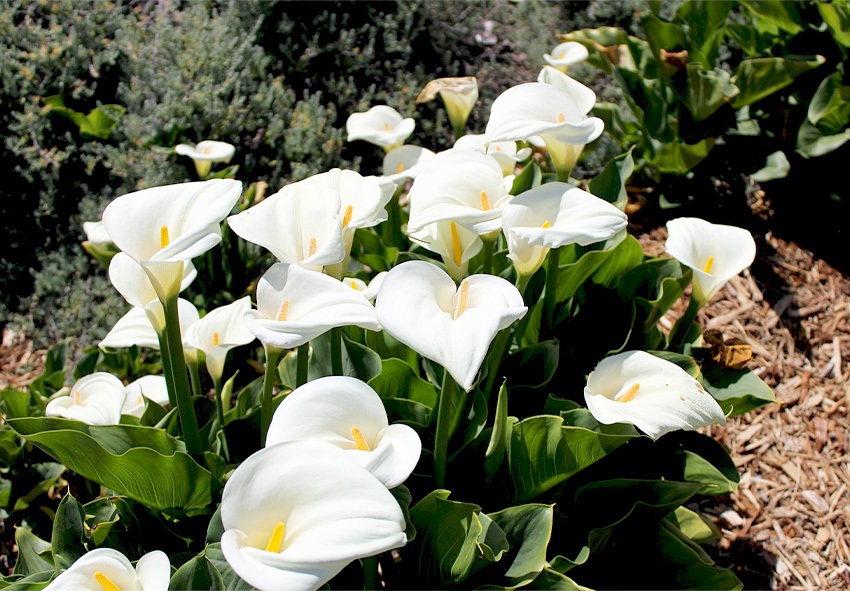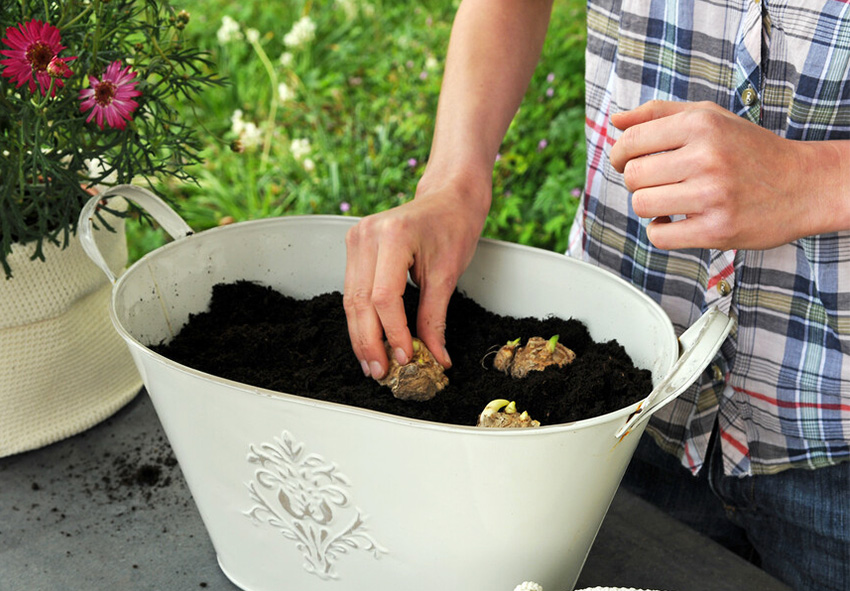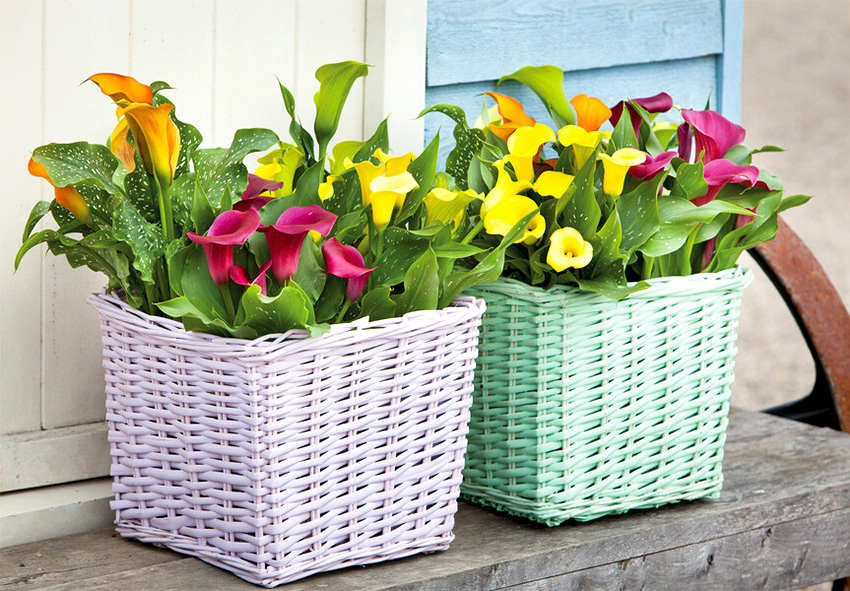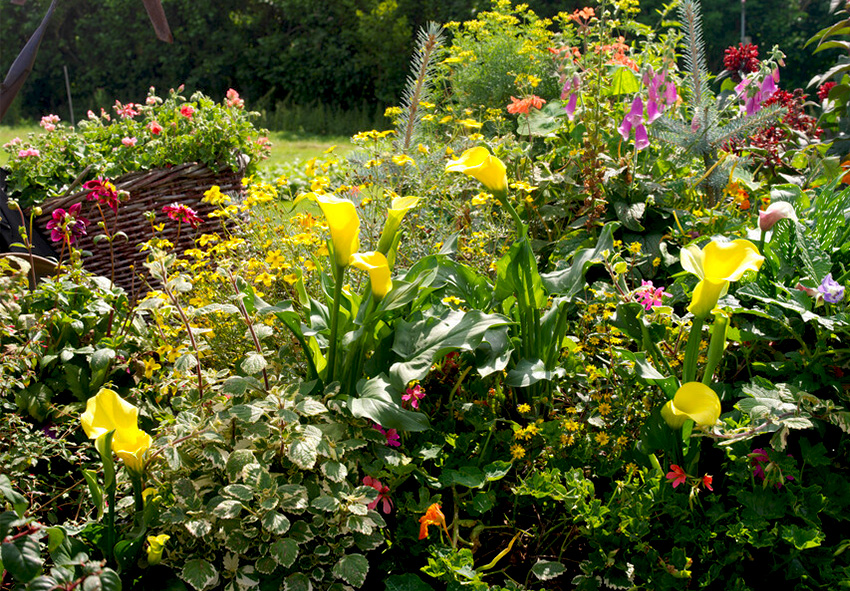Calla lilies are elegant and versatile flowers, admired for their sculptural blooms and lush green foliage. They are popular both in gardens and as cut flowers, symbolizing beauty, purity, and rebirth. This guide will cover everything you need to know about growing calla lilies — from planting and seasonal care to post-bloom maintenance and design ideas. Our gardening blog is a perfect place to find all the information you need!
Introduction to Calla Lilies

Calla lilies (Zantedeschia) are not true lilies, but they are cherished for their trumpet-shaped flowers and striking appearance. Native to southern Africa, they thrive in warm climates and are widely grown as ornamental plants. Their unique beauty has made them a favorite choice for weddings, floral arrangements, and garden landscapes.
What makes calla lilies unique?
Calla lilies stand out with their graceful form and long-lasting blooms. Their flowers can last for weeks, making them ideal for both garden displays and vases. The plants also feature lush foliage that complements their striking blossoms.
Symbolism and uses in gardens and bouquets
These blooms symbolize elegance, purity, and rebirth, often used in weddings and religious ceremonies. In gardens, calla lilies add a sophisticated touch to borders, pondsides, or containers. Their versatility makes them a go-to choice for both indoor and outdoor displays.
Overview of calla lily growing conditions
For calla lilies to thrive and produce their iconic trumpet-shaped blooms, they need the right balance of soil, light, water, and temperature. While they are relatively easy to care for, providing the ideal growing conditions will help ensure stronger plants and more abundant flowers. Below are the key requirements every gardener should know:
- Soil – Rich, well-draining soil with added organic matter is best for healthy root development.
- Light – Full sun to partial shade, depending on climate; too much heat may scorch leaves.
- Water – Keep the soil consistently moist during the growing season, but avoid waterlogging.
- Temperature – Calla lilies thrive in mild climates, ideally between 18–24°C (65–75°F).
- Hardiness zones – Suitable for USDA zones 8–10; in colder regions, they should be lifted and stored for winter.
Popular Calla Lily Varieties
Gardeners can choose from a wide range of calla lily varieties, from classic whites to vibrant colors. Each type offers unique features, making it possible to find a variety that suits your garden or floral design needs.
Classic white calla lilies (Zantedeschia aethiopica)
These are the most iconic callas, producing large, pure white flowers and thriving in damp conditions. They grow taller than colored varieties and are often used in traditional floral arrangements.
Colored calla lilies – pink, yellow, and purple blooms
Modern hybrids bring a splash of color to the garden, with shades ranging from deep purple to bright yellow. These smaller varieties are ideal for containers and mixed borders.
Dwarf and container-friendly calla varieties
Compact calla lilies are perfect for patios, balconies, and indoor pots. Despite their smaller size, they produce abundant flowers in striking shades.
How to Plant Calla Lilies

Planting calla lilies correctly sets the foundation for strong growth and abundant blooms. Whether in the ground or containers, providing the right soil and planting depth is essential.
Choosing healthy bulbs and rhizomes
Select firm, plump rhizomes with visible growth points. Avoid soft or shriveled bulbs, as these may fail to sprout. Healthy planting material ensures vigorous plants.
Best soil and location for planting
Calla lilies prefer rich, moist but well-drained soil. Choose a location with full sun to partial shade, depending on your climate. In hotter regions, some afternoon shade prevents stress.
Step-by-step planting guide for calla lilies
Planting calla lilies correctly ensures strong growth and beautiful flowers throughout the season. Whether you’re growing them in the garden or in pots, following the proper steps helps the bulbs establish quickly and produce vibrant blooms. Here’s a simple guide to get you started:
- Select the right location – Pick a sunny or partially shaded spot, depending on your climate, where the plants will receive at least 6 hours of light.
- Plant the rhizomes – Place them about 5–7 cm (2–3 inches) deep with the growing tips facing upward and space them 30 cm (12 inches) apart.
- Water thoroughly – Give the newly planted rhizomes a deep watering to help settle the soil and start root growth.
- Mulch and maintain – Apply a thin layer of mulch to retain moisture and keep weeds down, then monitor for even soil moisture as they grow.
Caring for Calla Lilies Throughout the Season
Once planted, calla lilies need consistent care to produce healthy leaves and stunning flowers. Regular watering and feeding are key to long-lasting blooms.
Watering and feeding requirements
Keep the soil evenly moist, especially during active growth. Apply a balanced liquid fertilizer every 2–3 weeks to support flowering. Avoid overwatering, as it can lead to rot.
Light and temperature needs
Calla lilies thrive in temperatures between 18–24°C (65–75°F). Provide full sun in cooler regions and partial shade in hot climates. Protect plants from frost, as they are not winter-hardy in cold areas.
Supporting healthy foliage and flowers
Healthy foliage is essential for photosynthesis, which fuels flower production. Remove yellowing leaves promptly, but never cut back green, healthy leaves during the growing season.
Calla Lilies in Containers

Growing calla lilies in containers is an excellent option for small spaces or decorative displays. Container culture allows for flexibility and easy overwintering in colder climates.
Choosing the right pot and soil mix
Use a pot at least 25 cm (10 inches) deep with drainage holes. A rich, well-draining potting mix is ideal, with added compost for nutrients.
Watering and fertilizing container-grown callas
Container-grown callas dry out faster than those in the ground, so water them regularly. Feed every 2–3 weeks with a liquid fertilizer high in potassium to encourage more blooms.
Indoor vs. outdoor container placement
Indoors, place containers near bright, indirect light. Outdoors, position them where they receive morning sun and afternoon shade. Rotate pots occasionally for even growth.
After Blooming: Calla Lily Post-Care
Once the flowering season ends, proper aftercare helps calla lilies recover and prepare for the next year. Caring for calla lilies after blooming ensures long-term health. Here are some main tips for you:
- Deadheading and pruning faded blooms: Remove spent flowers to prevent seed production, which drains energy from the plant. Cut flower stalks down to the base while leaving foliage intact. Regular deadheading also encourages the plant to store energy in its rhizomes. By focusing on foliage health, you’re helping next season’s blooms become stronger and more vibrant.
- Preparing calla lilies for dormancy: As foliage yellows and dies back, gradually reduce watering. This signals to the plant that it’s time to enter dormancy. Dormancy allows the rhizomes to rest and recharge for the next growing season. Proper timing ensures that your calla lilies will emerge healthy and ready to flower again.
- Overwintering calla lilies indoors or outdoors: In frost-free regions, calla lilies can remain in the ground with a layer of mulch for protection. In colder areas, lift rhizomes, dry them, and store in a cool, dark place until spring. Always label stored rhizomes to keep track of varieties. Check them monthly to make sure they are firm and not drying out or rotting.
Common Problems and Solutions
Like all plants, calla lilies can face pests and growing issues. Recognizing problems early helps keep your plants healthy and productive.
Yellowing leaves and what they mean
Yellowing leaves often indicate overwatering, poor drainage, or nutrient deficiency. Adjust watering and fertilizing to restore plant health. In some cases, yellowing is natural as the plant enters dormancy. Observing the timing and pattern of yellowing can help you diagnose the cause accurately.
Pests and diseases affecting calla lilies
Aphids, spider mites, and slugs are common pests. Fungal diseases like root rot can occur in poorly drained soil. Regular inspection and early treatment are key to preventing damage. Encourage beneficial insects in your garden to keep pest populations under control naturally.
Tips for preventing rot and overwatering issues
Always plant in well-drained soil or pots with drainage holes. Water moderately and never allow rhizomes to sit in waterlogged conditions. Adding mulch can help regulate soil moisture without causing soggy conditions. Consistent monitoring will prevent long-term issues and promote healthier plants.
Design Ideas with Calla Lilies

Calla lilies are versatile, fitting beautifully into both modern and traditional gardens. Their striking blooms also make them a favorite for floral design.
Calla lilies in garden landscapes
Use callas as focal points in borders or near water features. Their bold flowers pair well with ornamental grasses and leafy perennials. Plant them in clusters for maximum visual impact. Mixing colors creates stunning contrasts that brighten any outdoor space.
Using callas in cut flower arrangements
With their long stems and elegant form, calla lilies are excellent for bouquets. They last up to two weeks in a vase, making them perfect for weddings and events. Their timeless look fits both modern minimalist and traditional arrangements. Combine with roses or hydrangeas for a luxurious, eye-catching display.
Combining callas with other plants
Pair calla lilies with hostas, ferns, or begonias for a lush, layered effect. Their sculptural blooms contrast beautifully with softer foliage plants. They also thrive alongside moisture-loving companions, enhancing overall garden harmony. By mixing textures, you can create dynamic and visually engaging garden beds.
Conclusions
Calla lilies combine elegance and resilience, rewarding gardeners with stunning displays year after year. With the right planting, care, and after-bloom maintenance, they thrive in both gardens and containers. Whether used as landscape accents or cut flowers, calla lilies are a timeless choice for adding beauty to any space!
Frequently Asked Questions (FAQs) about Calla Lilies
1. How do you plant calla lily rhizomes correctly?
Plant calla lily rhizomes about 5–7 cm (2–3 inches) deep with the growing tips facing upward. Space them 30 cm (12 inches) apart in well-drained, fertile soil. After planting, water thoroughly to encourage root growth. Proper spacing and soil preparation help prevent overcrowding and disease.
2. Do calla lilies grow better in sun or shade?
Calla lilies thrive in full sun to partial shade. In cooler climates, they benefit from full sun to maximize blooming, while in hot regions, partial shade protects the foliage from scorching. Finding the right balance ensures strong growth and longer-lasting flowers.
3. Can I order calla lilies from your online store?
Yes, you can order dutch calla lilies from our online store Dutch-bulbs.com. We offer a variety of high-quality lily bulbs, including dutch varieties, perfect for adding vibrant color to your garden. We take pride in providing top-quality plants that are carefully cultivated and shipped with care to ensure they reach you in perfect condition.
4. How often should I water calla lilies?
Calla lilies prefer consistently moist soil during the growing season, but not waterlogged conditions. Water when the top few centimeters of soil begin to dry out. Container-grown plants may need more frequent watering, especially during warm weather. Reducing water after flowering encourages healthy dormancy.
5. What are common problems with calla lilies and how do I fix them?
Yellowing leaves often signal overwatering or nutrient issues, while pests like aphids and spider mites can affect plant health. Root rot is common in soggy soils. To fix these problems, improve drainage, apply balanced fertilizer, and treat pests with insecticidal soap. Regular monitoring keeps plants healthy and thriving.
Published: 07.10.2025
